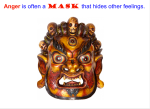 You had to stay in for recess. Another kid took the seat you had saved in the cafeteria. Somebody uninvited you to their birthday party. You got in trouble, but nobody else got caught. A classmate called you a name. You got bumped by a swinging backpack.. Are you feeling angry? Well, not exactly . . .
You had to stay in for recess. Another kid took the seat you had saved in the cafeteria. Somebody uninvited you to their birthday party. You got in trouble, but nobody else got caught. A classmate called you a name. You got bumped by a swinging backpack.. Are you feeling angry? Well, not exactly . . .
As you know, anger is a secondary feeling that layers on top of one or more other uncomfortable feelings. In my experience, kids have limited success working on managing their anger unless they are able to identify and address the feelings that underlie it. Here’s how I teach them to look behind the angry mask to figure out how they and others are feeling.
I use the concept of the angry mask with kids in all grades. In individual sessions, we often make a mask and a feeling face to go behind it. Here is an angry mask and underlying feeling made by a first grader who had been throwing rocks at two others who were calling him a name:
I begin introducing the idea of looking at feelings other than anger in my second grade class councils. I tell the kids that “sad” “mad” and “angry” are kindergarten words, and we’re going to use other feeling words instead. We focus on “disappointed,” “frustrated,” “upset,” “worried,” “scared,” “jealous,” and “hurt,” but kids are welcome to use all other feeling words. They LOVE the idea of using “big kid” words. Many times when I have asked kids about their feelings and they start to say “mad,” “sad,” or “angry,” they self correct and say, “Oh wait, that’s a kindergarten word,” and then describe their feelings more clearly.
Beginning in third grade, I teach the concept of the angry mask. Years ago, I bought a great poster, which illustrated the idea of anger as a mask that can obscure other uncomfortable feelings. It’s available here.
I’m not crazy about cartoon feeling faces, so last year I made SMART Board slides using photos of kids showing feeling faces. Here’s the first slide:
The subsequent slides feature smaller versions of the mask that kids move aside to reveal the feelings beneath. Here’s one of them:
We spend time talking about each of the feelings and coming up with examples of situations in which those feelings arise. We also talk about why people might mask their feelings — because they don’t understand what they are feeling, don’t know how to show the feeling, or don’t want people to know how they feel. There is always a great discussion about how people may be worried about embarrassing themselves by showing the underlying feelings, when actually, having a big angry fit is even more embarrassing, and is more likely to make others want to keep their distance from you.There is so much richness in these discussions that fourth graders welcome having a very similar lesson to what we did in third grade.
After our discussion, the kids work in partners or alone (their choice) on scenarios for which they identify what underlying feelings people are experiencing when they are acting mad. They complete the papers, and when finished write up their own scenarios. We end the class with everyone sharing the feelings they have identified and the scenarios they came up with. Here are the third grade and fourth grade papers. The third grade paper has some feelings listed to aid in spelling, but they can also use others, and are welcome to repeat them. This year, many of the third graders spontaneously listed several possible feelings, even though I only asked for one for each scenario. Third graders are asked to think about only one person’s feelings. Fourth graders go a bit farther and consider the perspectives of two people.
Kids have a much easier time working through their feelings after learning about the angry mask. If they tell me they are mad, I say, “And what’s behind the angry mask?” More often, I don’t even have to do that. If they even start with the angry feelings (often they jump to the underlying feeling) they will say, “I’m mad, but behind the angry mask is . . . ” The prinicpal and teachers know this language and are able to use “What’s behind the angry mask?” to help kids too.
Knowing about the angry mask also helps kids be better able to talk about and understand other kids with whom they are having conflicts. And when they’re talking about issues at home, they often talk about their parents’ angry masks and what might be behind them. (Sometimes this helps them have an “aha” moment about what behaviors they might change, and sometimes it’s profoundly moving. )
If you happen to see my angry mask, probably what’s under it is overwhelmed. This last month of school stuff is crazy, so I’ve been a very neglectful blogger. But I’m a contrite blogger too, and will try to do better. And now it’s 11:33 on Sunday night. Gotta go to bed or I’ll be wearing the tired mask all day tomorrow!
I’d love to hear what you do to help kids understand about underlying feelings and how anger can get in the way of addressing them.

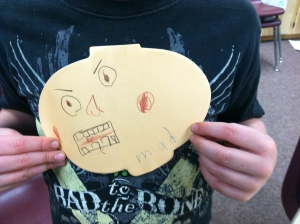
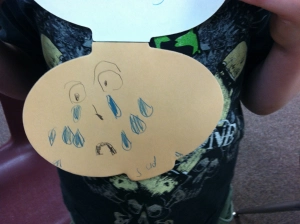
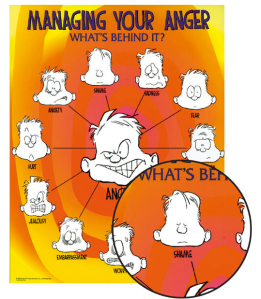
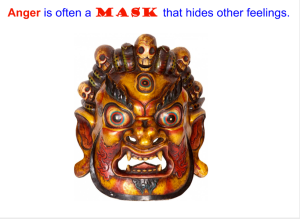
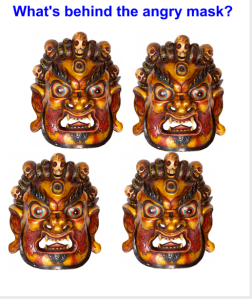
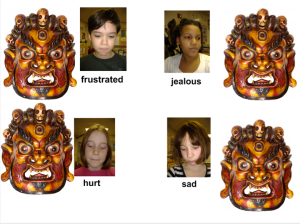
This is powerful stuff – kudos for helping them unpack their emotions!! Lots of times it’s fear, so I’ll usually ask, “tell me what you’re afraid of?” or “what’s something that scares you?” We also use a mirror to let them see how their face changes from their mad mask to their “I’m ready to process this now” face.
Our jobs certainly are HEART work!
Barbara
I love this lesson!
I am loving your blog and getting so many great ideas. Another counselor in my district drew an anger iceberg (anger is the tip of the iceberg and the names of other feelings are written underneath the water line, in the base of the iceberg). When I meet with a group of students or an individual who is angry, we talk about what’s underneath their anger and how it can be hard to reach those feelings — we need to melt the anger (cool down, diffuse, relax) to get to those underlying feelings. Will post a link to your blog on my local school counseling association’s facebook page — I want others to get your awesome ideas!
Thanks Barbara, Roxanne, and Jeanne for your kind comments and ideas. I love the mirror and iceberg ideas! I often say “I can see that you’re not ready to talk about this yet” or “You look like you’re ready to process this” but I never thought to SHOW them what I was seeing! (But I will now!) And what a great idea to talk about the iceberg of feelings! I think kids will really relate to the idea that the feelings that are underneath the waterline are larger than those above — and really need to be taken care of so your ship doesn’t sink! Definitely adding that into my 4th grade angry mask lesson next year!